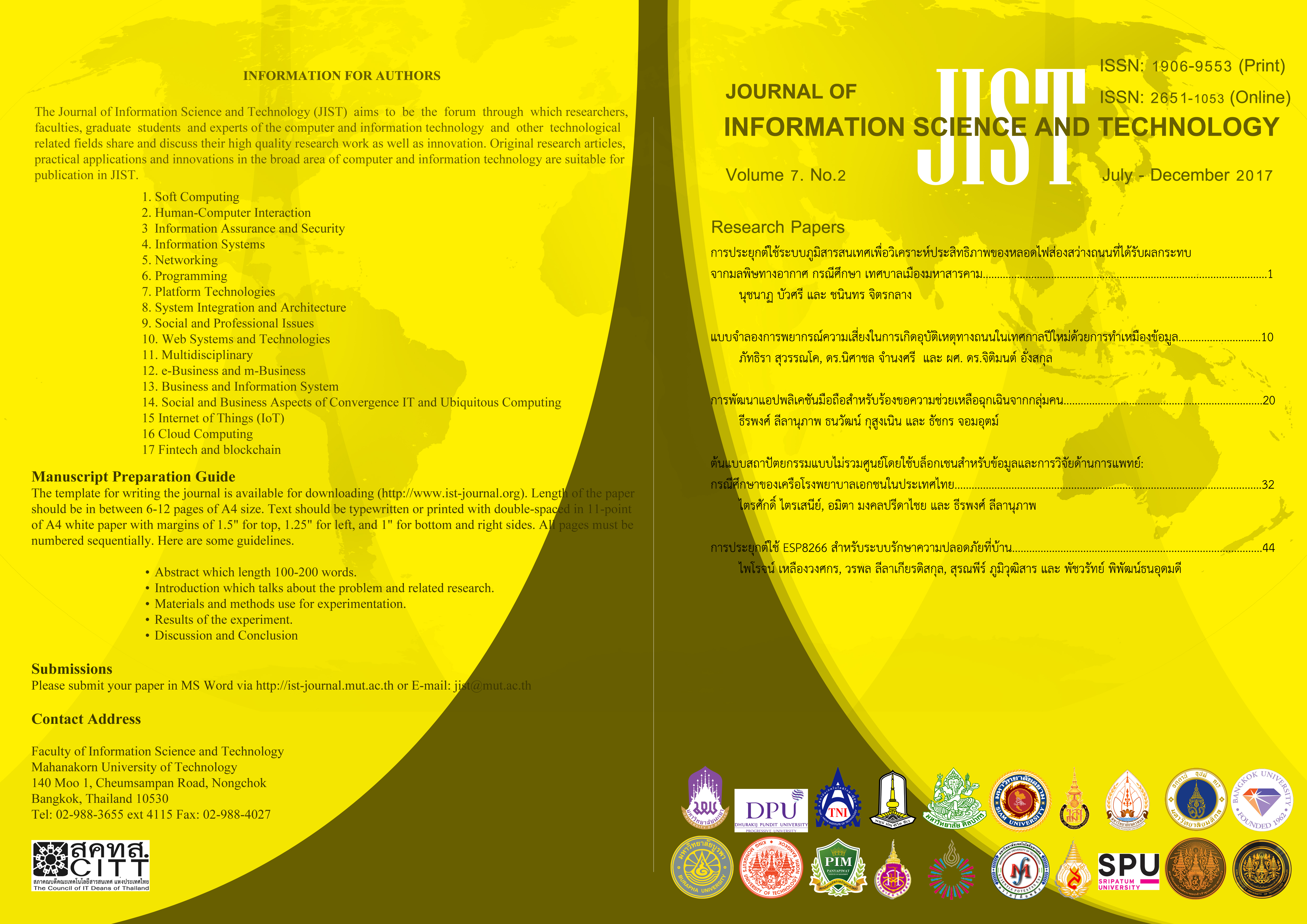The Development of Mobile Application for Requesting Emergency Assistance from Crowds
Main Article Content
Abstract
- At present, many crimes and emergency cases happen daily, especially in large cities. Thus, there are also a high number of requests regarding such cases. Some requests are very urgent until even the requesters cannot give details about their needs. Others are not emergency but still need to be responded by domain-specific people or experts. Unfortunately, due to a small number of polices and public officers, sending the assistances to respond all requests is often not fast enough to help the victims in time. Furthermore, locating and reaching the scenes are difficult when informed by phone or text, which is often unclear.This article aims to develop the mobile application for requesting emergency assistance from crowds based upon a crowdsourcing model. The purpose of this application is to create a society of mutual assistance, composed of three preliminary roles of users (i.e., help requesters, volunteers and officers.) By using our application, a help requester can make either an emergency and non-emergency request with a minimal effort. The request is subsequently routed to the potential recipients (e.g., volunteers and/or officers) based on, for instance, time, location, zone of crime levels, gender and profile of users. This is to avoid fraudulent requests like robbery, kidnapping, human trafficking, sexual assault, etc.
Article Details
This work is licensed under a Creative Commons Attribution-NonCommercial-NoDerivatives 4.0 International License.
I/we certify that I/we have participated sufficiently in the intellectual content, conception and design of this work or the analysis and interpretation of the data (when applicable), as well as the writing of the manuscript, to take public responsibility for it and have agreed to have my/our name listed as a contributor. I/we believe the manuscript represents valid work. Neither this manuscript nor one with substantially similar content under my/our authorship has been published or is being considered for publication elsewhere, except as described in the covering letter. I/we certify that all the data collected during the study is presented in this manuscript and no data from the study has been or will be published separately. I/we attest that, if requested by the editors, I/we will provide the data/information or will cooperate fully in obtaining and providing the data/information on which the manuscript is based, for examination by the editors or their assignees. Financial interests, direct or indirect, that exist or may be perceived to exist for individual contributors in connection with the content of this paper have been disclosed in the cover letter. Sources of outside support of the project are named in the cover letter.
I/We hereby transfer(s), assign(s), or otherwise convey(s) all copyright ownership, including any and all rights incidental thereto, exclusively to the Journal, in the event that such work is published by the Journal. The Journal shall own the work, including 1) copyright; 2) the right to grant permission to republish the article in whole or in part, with or without fee; 3) the right to produce preprints or reprints and translate into languages other than English for sale or free distribution; and 4) the right to republish the work in a collection of articles in any other mechanical or electronic format.
We give the rights to the corresponding author to make necessary changes as per the request of the journal, do the rest of the correspondence on our behalf and he/she will act as the guarantor for the manuscript on our behalf.
All persons who have made substantial contributions to the work reported in the manuscript, but who are not contributors, are named in the Acknowledgment and have given me/us their written permission to be named. If I/we do not include an Acknowledgment that means I/we have not received substantial contributions from non-contributors and no contributor has been omitted.
References
2. Georgios Chatzimilioudis, Andreas Konstantinidis, Christos Laoudias, “Crowdsourcing with Smartphones”. IEEE Internet Computing, vol.16, pp. 36-44, Sept.-Oct. 2012.
3. Stefan Steiniger, Moritz Neun and Alistair Edwardes. “Foundations of Location Based Services Lesson 1”. University of Zurich, CartouCHe1 - Lecture Notes on LBS , v. 1.0, 2006.
4. Jiawei Han, Micheline Kamber, Jian Pei. Data Mining: Concepts and Techniques. The Morgan Kaufmann Series in Data Management Systems, 3rd edition, Elsevier, 2011
5. Jiawei Han, Micheline Kamber, Jian Pei. Hands-On Machine Learning with Scikit-Learn and TensorFlow: Concepts, Tools, and Techniques to Build Intelligent Systems., 1st edition, O'Reilly Media, 2017
6. Shai Shalev-Shwartz and Shai Ben-David. Understanding Machine Learning: From Theory to Algorithms, Cambridge University Press, 2014.
7. Mike Roberts. “Serverless Architectures”. [ออนไลน์], จาก : https://martinfowler.com/articles/serverless.html, 04 August 2016
8. Chris Esplin. “What is Firebase?”. [ออนไลน์], จาก: https://howtofirebase.com/what-is-firebase-fcb8614ba442, 6 October 2016.
9. Sasu Tarkoma. Publish / Subscribe Systems: Design and Principles, Wiley, June 2012.
10. Isuru Madusanka and Rukman Bernard Fernando. Busy programmer’s guide to Firebase with Android, Leanpub, 2017.



